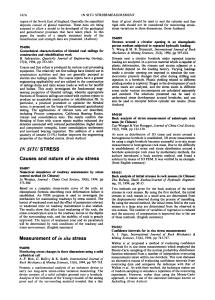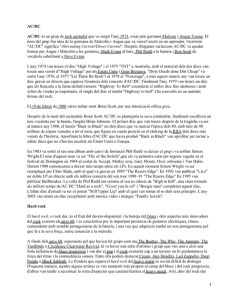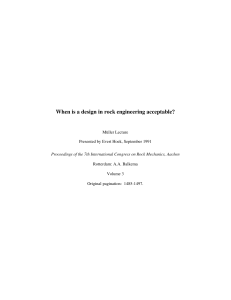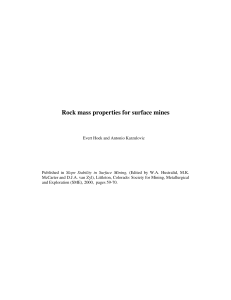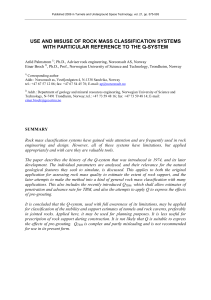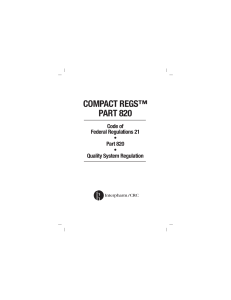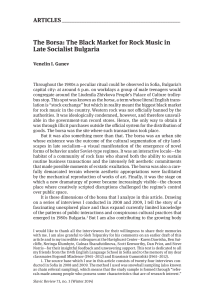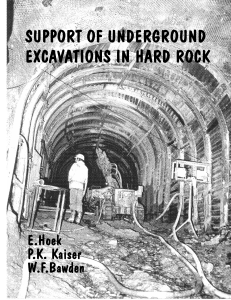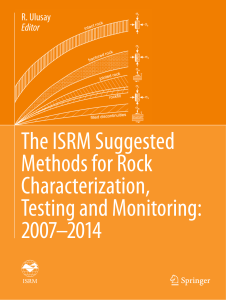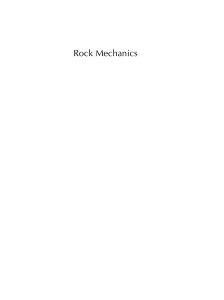THE HIDDEN GODS OF CHIUCHIU1
Anuncio
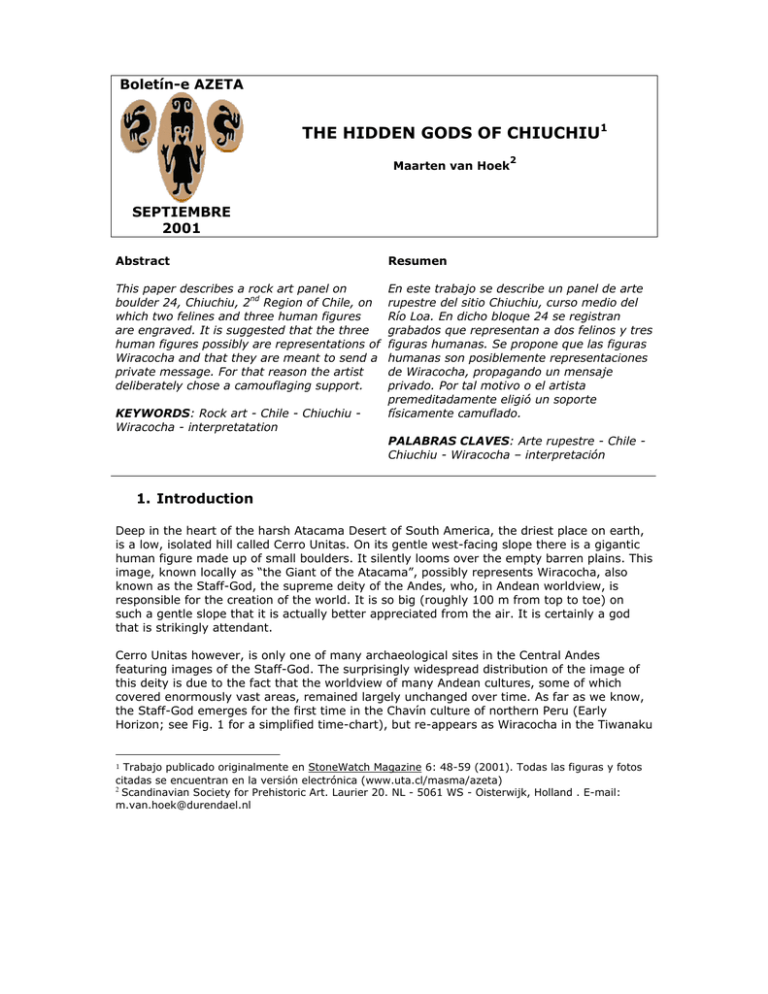
Boletín-e AZETA THE HIDDEN GODS OF CHIUCHIU1 2 Maarten van Hoek SEPTIEMBRE 2001 Abstract Resumen This paper describes a rock art panel on boulder 24, Chiuchiu, 2nd Region of Chile, on which two felines and three human figures are engraved. It is suggested that the three human figures possibly are representations of Wiracocha and that they are meant to send a private message. For that reason the artist deliberately chose a camouflaging support. En este trabajo se describe un panel de arte rupestre del sitio Chiuchiu, curso medio del Río Loa. En dicho bloque 24 se registran grabados que representan a dos felinos y tres figuras humanas. Se propone que las figuras humanas son posiblemente representaciones de Wiracocha, propagando un mensaje privado. Por tal motivo o el artista premeditadamente eligió un soporte físicamente camuflado. KEYWORDS: Rock art - Chile - Chiuchiu Wiracocha - interpretatation PALABRAS CLAVES: Arte rupestre - Chile Chiuchiu - Wiracocha – interpretación 1. Introduction Deep in the heart of the harsh Atacama Desert of South America, the driest place on earth, is a low, isolated hill called Cerro Unitas. On its gentle west-facing slope there is a gigantic human figure made up of small boulders. It silently looms over the empty barren plains. This image, known locally as “the Giant of the Atacama”, possibly represents Wiracocha, also known as the Staff-God, the supreme deity of the Andes, who, in Andean worldview, is responsible for the creation of the world. It is so big (roughly 100 m from top to toe) on such a gentle slope that it is actually better appreciated from the air. It is certainly a god that is strikingly attendant. Cerro Unitas however, is only one of many archaeological sites in the Central Andes featuring images of the Staff-God. The surprisingly widespread distribution of the image of this deity is due to the fact that the worldview of many Andean cultures, some of which covered enormously vast areas, remained largely unchanged over time. As far as we know, the Staff-God emerges for the first time in the Chavín culture of northern Peru (Early Horizon; see Fig. 1 for a simplified time-chart), but re-appears as Wiracocha in the Tiwanaku Trabajo publicado originalmente en StoneWatch Magazine 6: 48-59 (2001). Todas las figuras y fotos citadas se encuentran en la versión electrónica (www.uta.cl/masma/azeta) 2 Scandinavian Society for Prehistoric Art. Laurier 20. NL - 5061 WS - Oisterwijk, Holland . E-mail: m.van.hoek@durendael.nl 1 VAN HOEK / THE HIDDEN GODS SEPTIEMBRE 2001 culture near Lago Titicaca on the border of Peru and Bolivia (Early Intermediate Period and Middle Horizon) and, as we have seen, at Cerro Unitas in the Atacama Desert. Strikingly, these three cultural zones are more than 2000 km distant (Fig. 1A) and almost 2000 years apart ! Surprisingly, some of the most interesting images of the Staff-God however, are found hidden on a large boulder near Chiuchiu on the Rio Loa, about 300 km south of Cerro Unitas (Fig. 1B). This specific boulder, numbered 24, is situated in a river-gorge just north of the village of Chiuchiu on the precordillera of northern Chile. Interestingly, Boulder 24 actually was a rather unlikely choice to serve as canvas for the imagery that has been found on one of its surfaces. It notably bears petroglyphs that are only visible at really close range. The small images from Chiuchiu proved to represent “hidden” gods that are in striking contrast with the enormous dimensions of “the Giant of the Atacama”. The main question is, why were these “hidden” images executed on this specific boulder, while many other and “better” suitable stone surfaces were available ? In this paper it will be argued, that the choice of the manufacturer to especially take Boulder 24 as a canvas cannot be separated from its siting and orientation in the physical landscape. But also the perception of the landscape is of paramount significance. Yet, our perception of the landscape is completely different from the experiences of the manufacturer. When I visited the area, I was greatly impressed by the chain of towering volcanoes NE of Chiuchiu. For me volcanoes are exceptional and impressive natural features; for the manufacturer of the imagery they were sacred. They represented places to worship, to respect and to fear, as many of these imposing peaks were regarded to be the dwelling places of the Gods of the Mountains (Berenguer 1999: 39). Querejazu Lewis (1992: 61) describes these mountains as sacred places (huacas), where the “achachilas”, spirits of the ancestors, resided. Flowing from these considerations it will be obvious that there is no such thing as one landscape. It is the perception of one person, severely influenced by its own culture and habitat, that determines the contents of the spaces they live in or visit, and that perception varies and changes constantly over time. For that reason the concept of “mindscape” has been introduced. According to Ouzman (1998: 419) a mindscape is “a space that is both conceptual and has a definable physical locus”, and, more importantly, he also argues that “both the mind and the physical landscape affect each other in recursive fashions”. The impact of the Andean peoples on the landscape was also less physical and more conceptual in nature and allowed for multiple and even contrasting universes to exist, all of which are equally “real”. It is therefore not only imperative to physically describe the landscape. One has to understand that by engraving an image on a stone, the manufacturer turned the landscape into his or her “place”, and that the whole configuration (image, stone and landscape) is a reflection of the manufacturer’s “mindscape”. In order to explain the hidden character of the imagery at Chiuchiu, one must also enter the “mindscape” of the prehistoric manufacturer. Only when one tries to access the manufacturer’s “mindscape”, one will be able to possibly understand the “hidden” nature of these images. 2. The Atacama and its Art What most Andean cultures have in common, is a deep concern with the physical landscape, especially with stone. The many indigenous societies of the Central Andes used stone in many different ways to mark, enhance and organise their environment. And to express their beliefs they frequently used boulders and outcrops as canvas for their imagery. The Atacama Desert proves to be one of the very few places on earth where three much differing types of rock art are found together. The most common type of rock art in the Boletín AZETA © 1999-2001 - http://www.uta.cl/masma/azeta 2 VAN HOEK / THE HIDDEN GODS SEPTIEMBRE 2001 Atacama is the petroglyph, comprising all sorts of figures (iconic and non-iconic) that have been carved, chiselled, pecked or scratched onto stone surfaces. Less frequent are pictographs or rock-paintings and geoglyphs. The latter are often enormous figures on scree plains or hill slopes, like the Wiracocha figure at Cerro Unitas, that were made by either collecting small (darker) boulders to form a figure on the lighter sand, or to remove boulders and scree material to expose the differently coloured sand which then makes up the figure. The most famous examples are found near Nazca in Peru, but also in the Atacama of Chile more than 120 geoglyphs-sites are known. In the Atacama rock art sites often occur in very remote and lonely places. Because of the harsh arid climate of this region, this art is mainly found concentrated near places where water is or was available, but it is also clearly related to the paths between water places and near the many ancient caravan trails that once criss-crossed the desert. One of these places is Chiuchiu. The petroglyphic site of Chiuchiu, about 40 km NE of Calama (Fig. 2), can be reached by following a dirt track north through a gorge that has been cut out by the Rio Loa, the only river-system in a wide area that has sufficient water supply to reach the Pacific. To the north and east of this gorge are impressive vistas of the Andes and its powerful volcanoes (Fig. 3). The barren landscape directly east and west of the river-gorge is boringly flat and only when descending into the valley, water and sometimes vegetation becomes visible. The river looks more like a small brook, but is sufficiently fed all year round by melting water from the Andes and several springs from underground sources, so that there is always water. As a result of this constant water supply and the extensive irrigation systems, the valley floor features some green oases. South of the gorge is a plain with sufficient water supply to allow a fertile oasis. Although small, Chiuchiu gained much importance in earlier days being located at a strategic crossroads. For ages the people of Chiuchiu controlled the north-south traffic going through the gorge, but also the caravans travelling east and west via the Rio Salado and the Rio Loa. Especially near such important stopping places rock art often accumulated significantly. The archaeological zone (indicated by two modest signposts at either “end”) seems to be easily accessible, as it runs parallel with the edge of the valley floor for a few hundred metres, immediately east of the dirt track leading north from the village to Lasana. Some of the petroglyphs are easily visible from a car. To fully appreciate the petroglyphs and the atmosphere of the site however, it is almost imperative to view them from close range. But it is when ascending the slope, that one starts to realise that the inspection of the more than 75 decorated boulders that are lying scattered around, is not that easy (Fig. 4). First there is the fact that the Atacama is one of the driest places in the world. It hardly ever rains here. As a result, the slopes of the gorge consist of extremely loose sands, mixed with angular scree material of different dimensions, often hidden under the sand. Moreover, the angle of the slope is almost 45 degrees, which makes it even more difficult to walk. Another fact is that the site is located at about 2600 m OD, and this altitude is not really favourable for one’s achievements. Added to this is the often intensive solar radiation, especially at midday. My wife Elles and I visited the site during a warm winter-day in July 2000 and we experienced all the troubles mentioned above. Although many petroglyph panels overlook the valley to the west, there is no specific preference for any compass-direction. There is a priority however, for vertical or steeply sloping surfaces to be decorated. It therefore depends on the time of visit, which petroglyph shows up clearly. The petroglyphs at Chiuchiu are mostly found on large boulders, which appear to have once been broken off from the harder stone band at the upper end of the Boletín AZETA © 1999-2001 - http://www.uta.cl/masma/azeta 3 VAN HOEK / THE HIDDEN GODS SEPTIEMBRE 2001 slope, possibly by earthquakes that frequently shake the Andes. Most decorated boulders are either situated at the base of the slope or roughly halfway up on the steep slope. I could spot only one engraving of a large, west facing quadruped (a camelid ?) on a vertical panel high up this outcrop ridge. 3. Boulder 24 Importantly, Boulder 24 is one of the very few decorated rocks that are situated rather high up the slope, which adds to its “hidden” nature. It is a large conspicuous rock, not easily missed, but surprisingly easily ignored when searching for rock art. In fact, Boulder 24 was almost passed by me without noticing any of the petroglyphs (Fig. 5). Why was this stone almost ignored? There are several reasons for this. First of all, its decorated surface faces exactly to the north, and at the time of our visit (around 2.00 p.m.) the position of the sun (almost due north at that time on the southern hemisphere) was not quite favourable, as it produced only very little shadow-lines. Secondly, the decorated surface is rather rough and irregularities caused small amorphous shaded areas that conveyed no message. Most important however, is that its reddish-brown surface is larded with lighter buff-coloured lines and specks of different sizes. Therefore, at first sight, the rock’s surface appeared heavily stained in a natural way and the combination of all these factors distracted the eye from the petroglyphs that are hidden amongst the jumble of natural features of the rock surface. A fourth factor is that the images themselves are rather small (ranging from 15 to 30 cm) and moreover have been delicately executed. Added to this is the fact that the patination of the petroglyph-grooves and pecked areas is almost the same as the buff-coloured lines and specks. Therefore the petroglyphs, especially the pecked parts, perfectly merge with the natural features of the surface. These natural qualities of the boulder will not have escaped the manufacturers notice and therefore it may be concluded that his or her choice to place images on this specific surface with its camouflaging properties was a deliberate one. 4. The Petroglyphs of Boulder 24 Rock art imagery at Chiuchiu mainly depicts humans and animals such as, birds, toads, camelids and felines in several much differing styles and clearly dating from different periods. Non-iconic figures also occur, but form a minority. Surprisingly, Boulder 24 features only a small number of petroglyphs. Four small anthropomorphic and four zoomorphic figures can be disclosed, together with some scratching and possible amorphous pecked areas which enhance the camouflaging effect. It is significant that there are no images of camelids on this panel. Camelids at Chiuchiu mainly have been carved on west facing panels, where they are easily visible from the drove roads; they represent “public” imagery, in contrast to “private” imagery. On Boulder 24 three contrasting forms of iconic art exist: almost abstract depictions of serpents, sophisticated anthropomorphs and rather crudely designed felines. There are also notable discrepancies within the whole rock art group. For instance, the anthropomorphs on Boulder 24 are delicately executed in much detail compared to a most simple anthropomorph on Boulder 4, showing hardly any detail. Two of the zoomorphic figures on Boulder 24 clearly represent felines and probably depict pumas or jaguars (Fig. 9). The upper animal is depicted in an upright pose, as if it is jumping. This typical position is noted at other petroglyphic sites, such as the feline decorated with dots at the Confluencia Site on the Rio Salado, east of Chiuchiu. The feline should not only be regarded as a predator, but also as a guardian of domesticated llamas which, so is said even today, do not flee when a Boletín AZETA © 1999-2001 - http://www.uta.cl/masma/azeta 4 VAN HOEK / THE HIDDEN GODS SEPTIEMBRE 2001 feline is approaching a herd (Berenguer 1999: 13, 53). Aschero (1999: 106) also emphasises the dualistic nature of the feline in rock art by describing it as a predator and as a metaphor of the good hunter, or later, of the good shepherd. Klein (1972: 25) describes the jaguar as a mythological being and cultural hero, worshipped by the aboriginal peoples of the central Andes. Immediately east of the felines are at least four anthropomorphs. The uppermost example (Fig. 6) is a slender figure facing the observer with a distinct circular head, rayed like a “solar” symbol, and a head-ornament on its top. Facial features are not clearly visible or just possibly represented by crude pock-markings. Each arm is sharply bent and holds a stick or staff parallel to the body. Especially this feature identifies such figures as images of the Staff-God or Wiracocha. The upper part of the body consists of a long outline triangle pointing down to its lower body, which comprises a pecked area, roughly shaped like an hour-glass. Below the hour-glass are two short legs with small feet, pointing west. Two grooves crossing the lower part of the human figure may represent the two other animals. They run parallel to each other and comprise distinctly curved zigzag lines with short appendices and snake-like heads that are slightly raised and look upwards, so it seems. These snake-like figures may constitute an important part of the imagery on Boulder 24, as, together with the human figure and the nearby felines, they may symbolise components of the “human-bird-snake” trinity, a mythological being personifying the major attributions of the Jaguar God (Klein 1972: 48). This feline deity is also associated with Wiracocha (Klein 1972: 55). Except for the bird symbol, all components of a divine assemblage are represented on Boulder 24. In the middle section are two anthropomorphs (Fig. 7). The bigger of the two is almost identical to the uppermost human, but it has more distinctly developed facial features in a not quite circular head. Also, the upper part of its body is longer and comprises a pecked area that is more rectangular. The shoulders seem to be represented by a small pecked triangle. It seems to be justified to regard these three parts (triangle, rectangle and hourglass motif) to represent the dress of the figure. Its left arm holds a “staff” while a second “staff” is engraved parallel to it. To the east of this Staff-God is a second figure of uncertain status. It is smaller and less distinctly executed. Lower down the panel is a fourth anthropomorph (Fig. 8). It is almost similar to the other two figures, except that its head is again circular and is completely filled up with distinct pock-marks not representing facial features. Again, the possible “solar” symbolism of the head is most evident. The “staff” in its straight right arm (left for the observer) is much longer and not parallel to the body. 5. Dating And Relating Especially the images of the Staff-God on Boulder 24 may give us a clue about the dating of these petroglyphs. About 55 km further north from Chiuchiu, near La Isla on the Rio Loa, large concentrations of engravings and paintings have been found, including figures similar to the Staff-Gods at Chiuchiu, featuring “solar” heads and sharply bent arms holding “staffs”. Berenguer (1999: 30-31) dates these Rio Loa “radiant-head” figures roughly to the Early Intermediate Period (100 BC to AD 700). But also the resemblance with the huge Wiracocha geoglyph at Cerro Unitas is striking. Like the minute Staff-Gods at Chiuchiu, it features a “radiant-head” and has similarly sharply bent arms holding “staffs” as well. But despite the contrast in size they share an important characteristic; both are not easily visible. Boletín AZETA © 1999-2001 - http://www.uta.cl/masma/azeta 5 VAN HOEK / THE HIDDEN GODS SEPTIEMBRE 2001 Interestingly, also the well-known “Portal God” adorning the Sun Gate at Tiwanaku, Bolivia, may be regarded as a “radiant-head” or Wiracocha figure. It is generally accepted that the Tiwanaku culture (dating roughly from 200 BC to AD 1000), once spread from its administrative centre near Lake Titicaca in Bolivia well into the Atacama. It is therefore possible that the Staff-Gods on the Rio Loa are distantly related to the “Portal God” of the Tiwanaku culture (or vice versa), which, in turn, is distantly related to the supernatural Chavín staffbearer of the Early Horizon. Both the possible Wiracocha figures and the felines of Boulder 24 may therefore be regarded as Andean “leitmotifs” that relate to collective and well understood social and religious metaphors. The widespread distribution of such “leitmotifs” may point to a collectively understood repository of beliefs, integrating the people of Chiuchiu in a wider social Andean landscape. 6. Discussion At first instance I was inclined to ignore Boulder 24 because its small petroglyphs are so inconspicuously placed against the stained background of the rock’s surface that they are easily missed. The second impression was one of surprise, as, on close inspection, the mottled surface proves to conceal the images that prove to represent the Staff-God, an important Andean deity. The contrast between the importance of the imagery and its visual subordination is most puzzling. Why did the manufacturer chose to carve these important depictions onto an obviously camouflaging rock surface ? It must be realised that often culture determines to a great extent the artistic and esthetical achievements of the creator of the imagery. Lee (1992: 12) remarks about rock art imagery on Easter Island: “Those who carved sacred designs were under constraints because accuracy dominated religious ethics”. It is certain that also the manufacturer of the hidden Staff-Gods on Boulder 24 must have had a great respect and awe for his or her god and will therefore have been “under constraints” as well. It is therefore almost inevitable that this respect and awe was expressed by creating images that “would have pleased Wiracocha”. From this point of view the manufacturer would have done his or her best to produce pleasing images that derived from his or her own esthetical and cultural background. The fact that the three “Staff-Gods” on Boulder 24 differ in detail, indicates that a certain level of idiosyncrasy was allowed for. But the fact that she or he took the trouble to make three images of the Staff-God on the same surface (as there is hardly any stylistic difference between the three similarly designed anthropomorphs, I take it that they all are by the same hand), implies that the manufacturer was well aware of the natural properties of the rock’s stained surface and its camouflaging effect on an observer, especially as “better” suited rock surfaces abound in this zone. Nevertheless, it was decided to decorate this specific surface, most probably on purpose. This may mean that the manufacturer either was aesthetically pleased by the stained surface of Boulder 24, or she or he regarded the mottled surface as an important part of the design. Or perhaps both. Or perhaps there are other reasons. If the manufacturer chose this specific surface only for esthetical purposes, this then clearly demonstrates the enormous discrepancy of esthetical appreciation between ancient manufacturer and present-day observer. The latter tends to put a work of modern art in the spotlights. The delicate detail, with which the three Staff-Gods have been executed, notably implies that these images must have been very important for the manufacturer. But the result is so meager in terms of visibility, that no doubt there will have been other reasons than esthetical ones to select this surface. These reasons may well lie within the rock itself. Boletín AZETA © 1999-2001 - http://www.uta.cl/masma/azeta 6 VAN HOEK / THE HIDDEN GODS SEPTIEMBRE 2001 Not only the imagery will have been important; also the specific natural properties of a rock surface may have been most meaningful in cultural respect. Consequently, also the orientation and the natural stained appearance of Boulder 24 may have been important factors for selecting this surface. But there is another important aspect about the rock as a canvas. It notably becomes increasingly accepted that the rock surface, on which rock art has been put, does not (always) constitute a neutral, meaningless support (Lewis-Williams & Dowson 1990: 5). Instead, rock surfaces and water surfaces are often regarded as a “veil” between ordinary life and the supernatural realm (Ouzman 1997: 90), and especially natural holes, cracks and irregularities in a rock face may have been regarded as entrances to the supernatural world (Lewis-Williams & Dowson 1990: 12). Just possibly, the manufacturer of the rock art images on Boulder 24 considered the natural stains also to be entrances to other levels of existence. Especially the two Staff-Gods with no facial features may well face into the rock. This whole idea fits into the concept that “Andean arts often served to unite planes of existence, characterise change and document transformation” (Stone-Miller 1995: 16). There may be, however, another important explanation why the manufacturer chose this stained surface, ignoring or even requiring its camouflaging effect. Stone-Miller notably claims that “Andean art favoured the symbolic reality, the inner core, over outward appearance” (1995: 16). She further argues that “essence explains how the Nazca lines are too large to be seen; it is not necessarily important that an image be visible for its essence to be obeyed”. It is also this concept which may explain the difference in size between the enormous Cerro Unitas figure and the hidden Staff-Gods at Chiuchiu. Following this line of argumentation, it is most likely that especially the anthropomorphic imagery on Boulder 24 was not executed for esthetical purposes or for an audience to be seen, but that it was created to convey a complex but private message or prayer of the manufacturer to the gods, ancestors or mythical beings existing in other planes of existence. Each of the three Staff-Gods notably is dualistic of character, as the heads of the figures are distinctly sun-related, whereas the dresses represent the secular world. The solar character possibly refers to an upper or supernatural level of existence and the images may therefore have been created to personally address the powerful Sun-God. Possibly, it is the private nature of these “messages or prayers to the Sun-God” that may have been the reason to engrave these images on a north facing rock surface, addressing the sun at midday ! I must conclude that the artistic achievement and the aesthetic impact of the petroglyphs on Boulder 24 are subordinate to their possible metaphorical contents. It proved also, that not only the imagery is of decisive significance; also factors such as the rock support and the positioning of the rock in a “mindscape” play a vital role. If indeed the images were not meant for other humans to be seen, selecting exactly the north face of a boulder rather high up the slope but also their rather small dimensions inconspicuously positioned on a rather camouflaging support warranted their private character and function. References ASCHERO, C. 1999 Rock art of the Puna desert and Northwestern Argentina. In: Rock art in the Andes of Capricorn. Museo Chileno de Arte Precolombino, Santiago de Chile. BERENGUER, J. 1999 The vanishing language of rock art in the Andes of Atacama. In: Rock art in the Andes of Capricorn. Museo Chileno de Arte Precolombino, Santiago de Chile. Boletín AZETA © 1999-2001 - http://www.uta.cl/masma/azeta 7 VAN HOEK / THE HIDDEN GODS SEPTIEMBRE 2001 KLEIN, O. 1972 Cultura Ovalle. Complejo Rupestre “Cabezas-Tiara”. Petroglifos y pictografias del Valle del Encanto, Provincia de Coquimbo, Chile. Scientia 141, 5-123. Valparaiso. LEE, G. 1992 The rock art of Easter Island; Symbols of Power, Prayers to the Gods. Monumenta Archaeologica 17. Los Angeles. LEWIS-WILLIAMS, J. and T. DOWSON 1990 Through the veil: San rock paintings and the rock face. South African Archaeological Bulletin 45, 5-16. Witwatersrand. OUZMAN, S. 1997 Landscapes/Mindscapes. In:The Semiotic Review of Books, 8.3, Bouissac, P. (ed.), pp. 3-5. Toronto. 1998 Mindscape. In: Encyclopedia of Semiotics, Bouissac, P. (ed.), pp. 419-421. Oxford University Press, New York. QUEREJAZU, R. 1992 Rock art as part of the popular Andean religiosity. Survey V-VI: 7-8; 61-66. Pinerolo. STONE MILLER, R. 1995 Art of the Andes, from Chavín to Inca. Thames and Hudson, London. Boletín AZETA © 1999-2001 - http://www.uta.cl/masma/azeta 8
